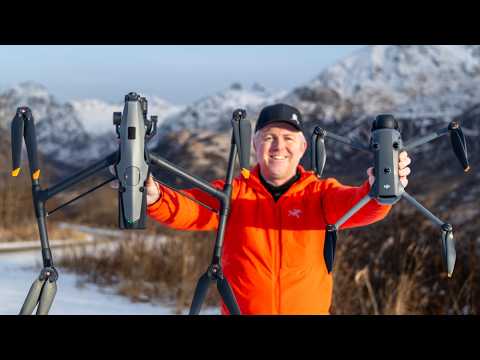Mavic 4 Vs Inspire 3: Is DJI’s Flagship Cinema Drone Worth 10x More?
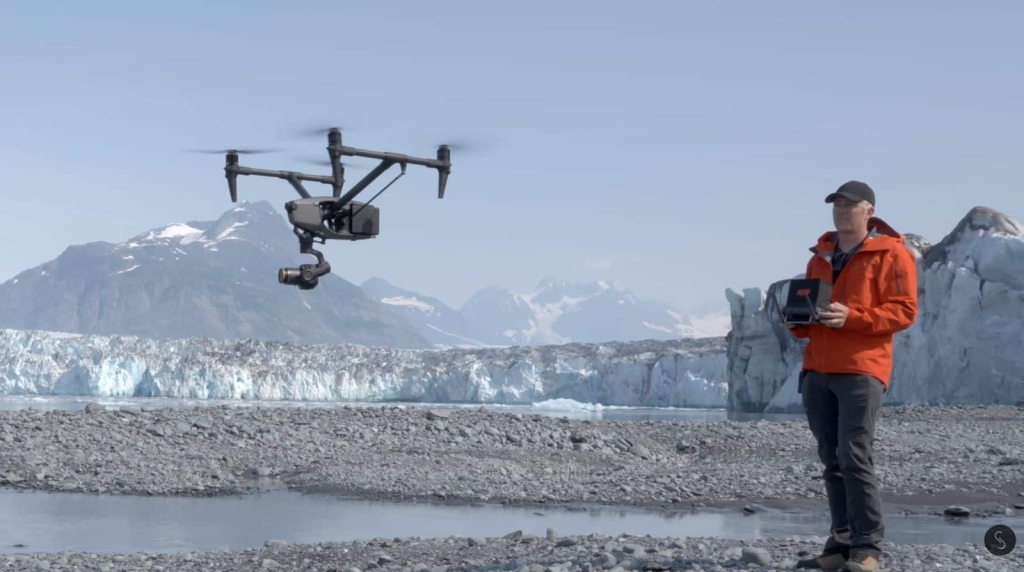
DroneXL Exclusive: Up To $40 Off Skyrover X1, S1 Drones With Amazon Prime Delivery
Now that the DJI Mavic 4 has been out for a bit, is it really worth it to spend 6 to 10 times more than that to buy the Inspire 3? Let’s go test and compare and see just how close the Mavic 4 comes to DJI’s flagship cinema drone.
Understanding the Differences
Now I am going to break down the differences between these two drones because they are significant—these are two very different tools aimed at two very different people. But the real question is: how close does the Mavic 4 come to the Inspire 3? Because the Mavic 4 has that 4/3 main camera that is capable of filming 6K up to 60 frames per second and it looks really good. It does a fantastic job. So, you get this beautiful D-Log or D-Log M. Yes, I know there’s the auto ISO feature that if you want to get the max dynamic range out of the DJI Mavic 4, you put it in auto ISO and you get this little extra bump in the highlights with D-Log M. And some of these were shot in D-Log. Some of these were shot in D-Log M. But the main thing is the Mavic 4 now has three fantastic cameras that can capture—well, the main camera can capture 6K up to 60. The other two cameras can capture 4K up to 60. And then also you get some slow motion modes which we’ll talk about in a minute: up to 4K 120 frames per second in the main and the 70mm camera and 4K 100 frames per second in the 166mm camera.
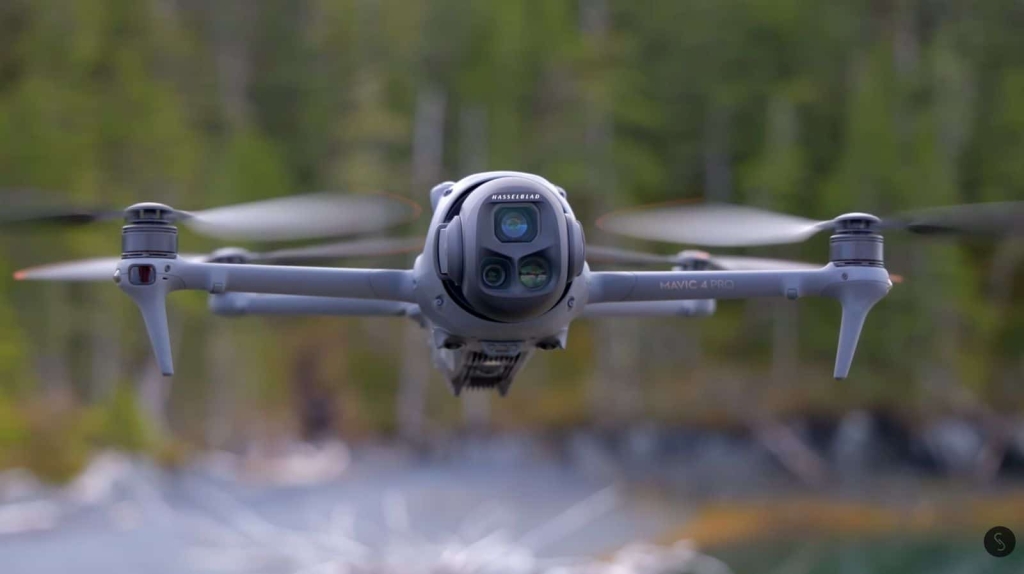
Now, on the other hand, the DJI Inspire 3 is a full-frame camera that is capable of filming up to 8.1K and if you get the RAW license, up to 75 frames per second in 8.1K. And the big advantage for the Inspire 3 is that you can film in ProRes RAW, which means you get a huge amount of flexibility in post if you want to edit the footage. ProRes RAW is incredibly flexible in post if you want to do things like adjust the ISO, white balance—there’s just a lot of things you can do with this footage.
File Sizes and Image Quality
Now, the difference between these two is while the Mavic 4 can film in all-I compression, which is fine—I wish they had stuck with ProRes coming from the Mavic 3 Cine, but whatever—the difference in data rates is massive. The file sizes for the Inspire 3 are absolutely huge, whereas the Mavic 4’s are significantly smaller even in the all-I codec. But when we put the footage side by side, here’s where it was interesting. I feel like yes, there’s a great level of detail in the Mavic 4 because it’s filming 6K and the difference between 6K and 8K is 2K. Yes, I know I can do math, but there isn’t a huge difference in the level of detail.
But where I do see a massive difference beyond the fact that the Inspire does ProRes RAW and the Mavic 4 does not is that the depth of the image—I don’t know how else to describe it, but it comes from the optics that you put on the Inspire 3. There is just a much higher quality depth of image through the optics because the optics are so much better on the Inspire 3 on the main cameras.
Interchangeable Lenses: Pros and Cons
Now, being able to switch lenses can be an advantage and a disadvantage. One of the things that’s both a plus and a minus for the Inspire 3 is interchangeable lenses. This means that you can’t just, you know, have the drone up in the air and change cameras like you can on the Mavic 4. You have to bring the drone down, swap out a lens, and then go back to flying. But there are advantages to being able to do that, and that is these really much higher quality lenses that you get with the Inspire 3 than you do with the Mavic 4.
Depth of Field
One of the things that is immediately noticeable between something like the Inspire 3, which is a full-frame camera, versus the Mavic 4, which has much smaller sensors, is the depth of field you can get when you have a 75mm on something like the Inspire 3 versus the 70mm on the Mavic 4. There’s a big difference in depth of field. You can get a much more shallow depth of field, not just because the Inspire 3 lens goes to f/1.8, which works better in low light, but also because the full frame gives you that shallower depth of field. So, it means your focus is much more critical. Again, why you need two people, but also gives you these beautiful, buttery, creamy backgrounds that can just look amazing.
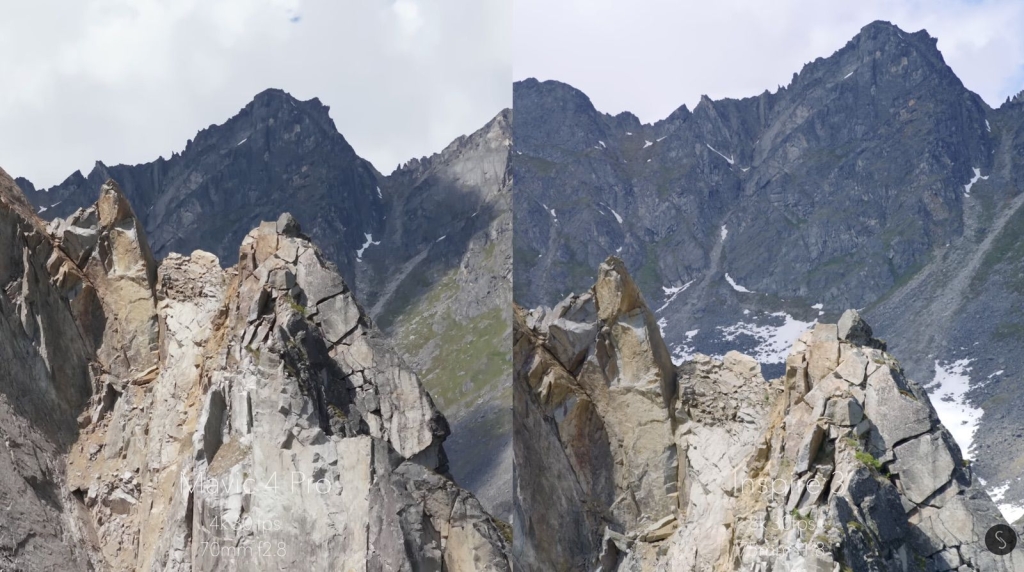
Lens Options and Focal Lengths
So, obviously with the Mavic 4, you can throw it in the air and you have access to three different cameras at three different focal lengths. And the Inspire 3, you have to land it and switch lenses. Also, there is no super long telephoto lens, at least not made by anybody who makes it work natively. That being said, I have put a 135mm on the Inspire 3 using Make Art Now’s counterweight system, and we’ll talk a little bit more about that when we talk about low light. But you can get longer lenses on there. It’s just you don’t get focusing or aperture control or anything like that.
Now, the 90mm from Viltrox is a fantastic lens that I absolutely love. And I hope that they come out with something like a 135mm in that same sort of form factor that gives you focusing and aperture control. That would be absolutely amazing. But of course, because you’re filming in 8K with all of the lenses with the Inspire, you can crop in 200% and still get a full pixel-for-pixel 4K readout. And so if you’re filming on the 75mm, that puts you at 150mm. If you’re filming on the Viltrox 90mm, that puts you at 180mm. So, you can match that super long focal length. It’s just you’re limited to 4K. I know that’s a huge limit, especially if you’re just putting stuff on YouTube. But for most of the things that I use the Inspire 3 for, there’s a reason I’m using the Inspire 3—the director, the project, whatever I’m working on needs and wants that full 8K readout that they want to be able to use to match up to a Red Raptor or whatever else we might be working with.
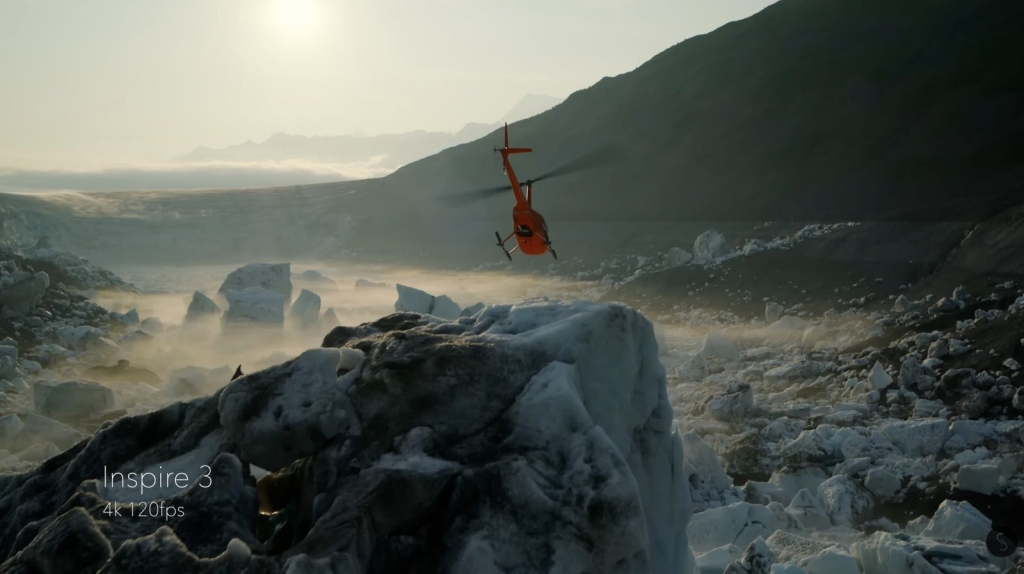
Photo Capabilities
And that spills over into photos. When you’re filming with the Mavic 4, you get this 25-megapixel sensor that can be split up into four because it’s a quad Bayer sensor, and then you get 100-megapixel photos. The downside of doing that is that you lose some dynamic range and so personally—I mean the 25-megapixel photos look great. On the other hand, the Inspire 3 has this I think 45-megapixel sensor which is fantastic. It’s got a ton of dynamic range and the images are really, really very beautiful.
Now this is where there’s some divergence between these two: the Inspire 3, yes, finally did get auto exposure bracketing, but there are no real other features like being able to make or automatically do panoramas and stitch them together. You can do panoramas. You just have to do it all manually. There’s no time-lapse or hyperlapse functions or anything like that. Whereas the Mavic 4 has a lot of those functions built in.
Obviously, the Inspire 3 has the best looking photos because you are getting a true 45-megapixel sensor with all of the depth of field in those higher-end elements from the glass, the lenses that you’re putting on there. So, you get some fantastic photos at all the different focal lengths if you have all those different lenses. But the Mavic 4 is definitely no slouch. The photos coming out of it look great. You’re talking 25 megapixels. They’re still really fantastic and they have really good quality to them.
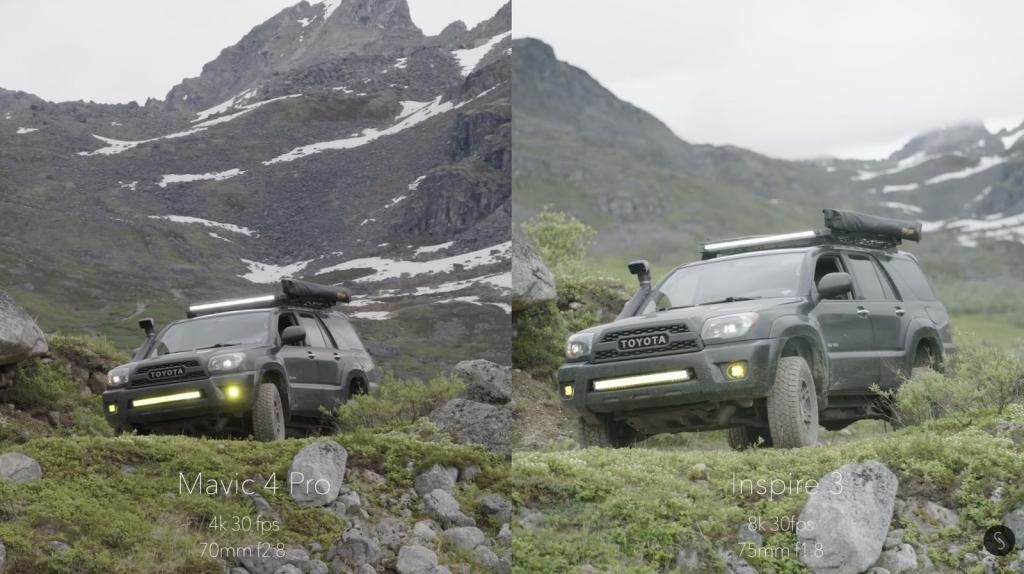
Low Light Performance
But then we come to what might be the biggest reason to look at something like the Inspire 3, sort of, and that’s low light. The Mavic 4 does really well in low light. It has actually for a small drone this size exceptional image quality in low light. It really does well partly because it has that larger Four Thirds sensor and that f/2 aperture. So, you get a fair amount of light coming in and you can get some really decent, really nice low-light shots.
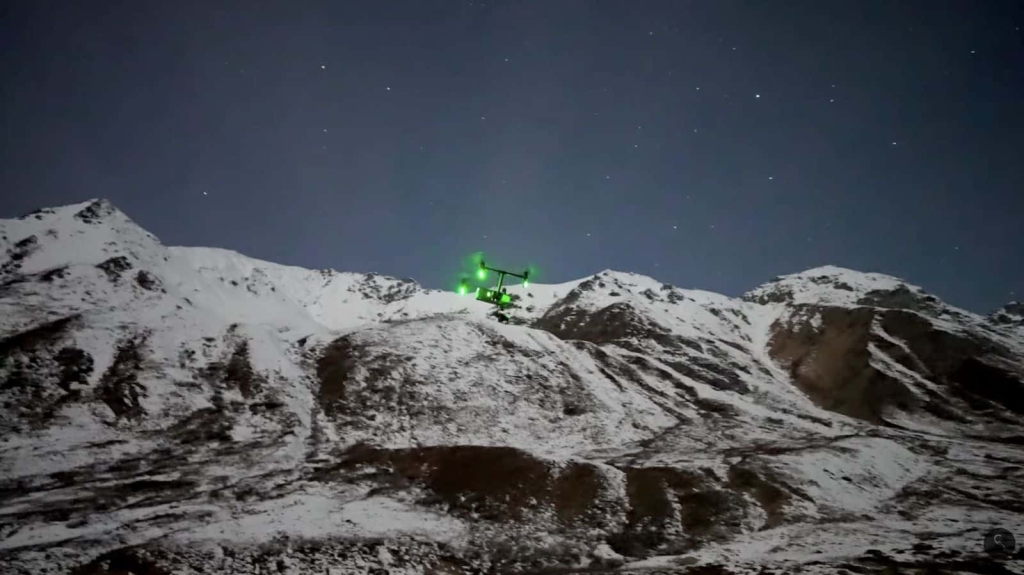
But the Inspire 3 is on a whole different level. And that’s for two reasons. One is you have a full-frame sensor, so you get a lot more light-gathering capability. And you can have the 75mm at f/1.8. So, it lets a little more light in than the f/2 lens of the Mavic 4, but you can also adapt other lenses. And adapting other lenses like a Voigtlander f/1.2, I think it was a 40mm, and then a TTartisan’s 50mm f/0.95 has enabled me to go out and film shots like this using nothing but moonlight. This is a full moon on a snow-lit scene where this is impossible to do with the Mavic 3 or Mavic 4 and I have tried it—you just cannot do it under nothing but moonlight. Whereas modifying and adding these third-party lenses to the Inspire 3 opens up a whole new level and a whole new ability to capture shots in extremely low light.
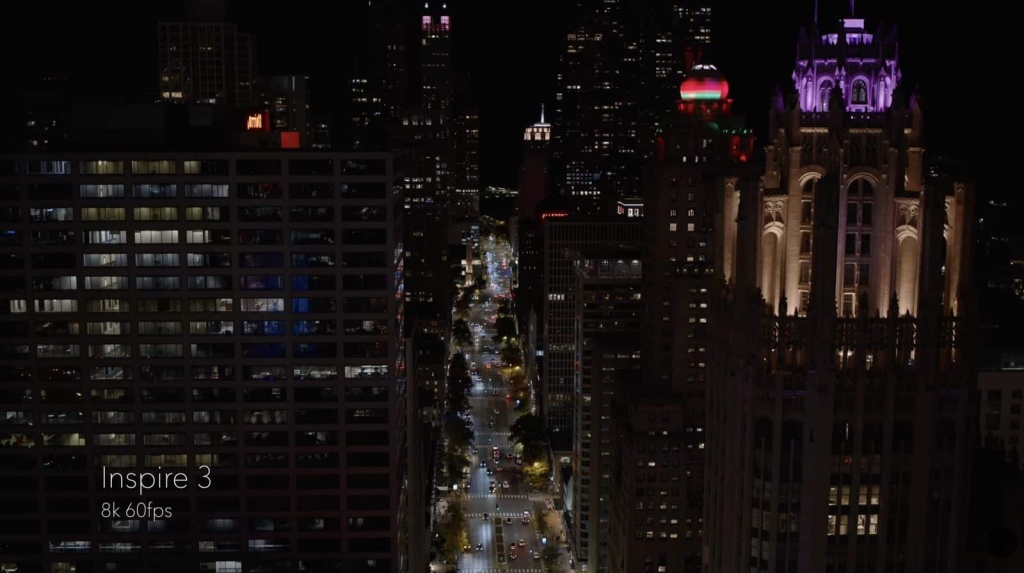
Physical Differences and Setup
So, I guess not surprisingly, the Inspire 3 does still win, but not by as much as I thought it would. The Mavic 4 definitely carries a lot of weight in image quality, especially on that main camera. But then we come to the physical differences. So, the first big difference between the Inspire 3 and the Mavic 4 is how fast you can set up each drone. See, for the Mavic, obviously, it’s a lot more simple and a lot faster to set up and go. Remote, drone. And DJI’s included that new automatic power-on feature. Now, I’ve been flying this already, so it’s not coming from a cold start GPS-wise, but essentially, there we go. We’re now ready to take off and fly.
The Inspire 3, on the other hand, it’s quite a different story because you’ve got the drone, remote, propellers. I’ve already got a set of batteries in here and the camera. Oh, and SSD. Let me get this out of the way so you can see. So, I mean, it’s going to take quite a bit more to get this set up, but we’ll do something similar. And yes, I know these are really aimed at very different markets. And we’ll get into more of that later, but the big thing is it used to be you needed the Inspire 3 in order to get that image quality. And with the Mavic 4, that is not as big of a difference as it used to be.
Some of the other differences is the size. I mean, the Inspire 3 needs a whole suitcase to carry it in and a lot of accessories to make it work. Whereas the Mavic 4 is pretty much, you know, you could fit it in a backpack with this, a couple batteries, and a remote very easily. It is much smaller and obviously much lighter weight, much smaller, much easier to fly in many places. And it used to be that the top speed, the Inspire 3 would give you that close to 60 mph, whereas no other drones did. Well, now the Mavic 4 does give you close to 60 mph depending on the conditions.
Battery Life and Professional Features
And some of the other major differences is obviously the battery life is about 20 minutes. The battery life on the Mavic 4 is about 40 minutes depending on how you’re flying. So half the battery life plus it takes two batteries at—well it used to be $350 a pop. Now I think it’s $530 a pop in the US. You can do the math—12 sets of batteries. That’s a huge investment. But obviously the Inspire 3 is built for professional workflows. It is built for two people to operate: one person to use the camera and one person to pilot the drone.
The other thing that makes it professional is that it has these swappable SSDs. That makes a huge difference. When you come into land, swap SSDs, you hand the SSD off to a DIT and they offload the footage while you swap batteries and get right back in the air. The Mavic 4 doesn’t have that option for the higher codec. It has the internal memory, but you can also use an SD card.
Signal Range and Obstacle Avoidance
But also in some of the other things that I’ve noticed, the Inspire 3, while it has good signal range, it does not have nearly the signal range of the Mavic 4 or the Air 3S or even the Mavic 3 sometimes would beat it out, which I’m not really sure why considering you have this huge remote with these big huge antennas. So built for professionals, for crews, for operating on big sets. That’s why it’s a full-frame 8K, multi-lens, everything else. And I will say that the footage you get out of the Mavic 4 is very good and could definitely be used on a lot of production types. It’s just if you want Netflix-approved big huge productions to match up, then the Inspire 3 is really one of your only options unless you’re jumping into something like an Alta series.
They both have 360-degree obstacle avoidance, but the Mavic 4 has much better obstacle avoidance because it works in much lower light and it has LiDAR. The Inspire 3 does not have forward-facing LiDAR, but it does have the forward-facing FPV camera. Again, focused at professional users who are dual operating. So, one person’s operating this camera and one person is flying the drone using this camera or using the side sensors to kind of see and make sure they’re navigating obstacles.
Smart Features
But a huge difference between these two is smart features because the Inspire 3 is built to be operated by two people and there are way fewer smart features. Now, it does have subject tracking, but the drone will not fly along with a subject. You have to fly it along, but it will track a subject while you’re flying the drone. So, that is useful, but that’s it. Whereas the Mavic 4 has Active Track. It has all kinds of smart quick shots that you can use, which does make it kind of nice when you’re out in a place like this, filming maybe by yourself, and you want to just get some really nice shots. The Mavic 4 is super easy for that.
So, while the Mavic 4 has a really robust set of smart features that help a single operator be able to operate it and get some really great shots, the power of the Inspire 3 comes when you’re operating it with two people because it enables you to capture footage and shots that are just next to impossible to capture with the Mavic 4 because of how close you might be trying to fly to things and being able to have one person solely focused on flying the drone and one person solely focused on using the camera and you have that FPV feed as well as the camera feed to where you can see enables you to capture some really breathtaking, very dynamic shots that are just really difficult to pull off with one person and a Mavic 4. But like I said earlier, if you want to track yourself or capture shots like that where you’re not having to fly the drone as much, yeah, the Mavic 4 is going to be the winner.
Also, while I know it can be done, it is significantly more terrifying to hand launch or hand catch the Inspire 3. The Mavic 4, not a big deal.
Conclusion
Next, you’re going to want to watch this video right here. I’ll see you over there. As always, if you have questions, ask me in the comments below or join my live stream, which happens most Wednesday nights at 4:00 p.m. Alaska time, 8:00 p.m. Eastern. At least if I’m not out in a place like this doing stuff like this. I’ll see you again soon in the next one. Cheers.

